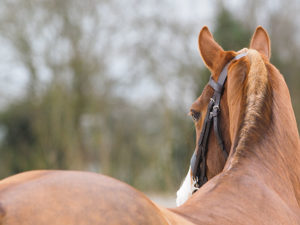Pasture Management 101: High-Traffic Areas and Overgrowth
High-traffic and overgrown areas are essentially opposites. The first is the consequence of overuse, while the latter results from underutilization. Both require management in horse pastures.
Managing High-Traffic Areas
Ideally, try to keep horses out of high-traffic areas to allow them to regrow. If that’s not possible, both Jennie Ivey, MS, PhD, assistant professor and extension equine specialist at the University of Tennessee Institute of Agriculture, and Dewitt Simerly, a district conservationist with the United States Department of Agriculture’s Natural Resources and Conservation Service, suggest using geotextile fabrics and gravel designated for heavy use to fortify the areas. Implementing a heavy-use area designed to facilitate drainage and prevent mud while also withstanding wear and tear from horse hooves is ideal.

“Typically, heavy-use areas consist of removing the topsoil, placing a layer of geotextile fabric at the bottom, followed by 8-12 inches of gravel ranging in size from 1 inch (base layer) to a stone dust or sand (top layer) to facilitate drainage and prevent hoof damage,” Ivey said. “Tall fescue can also be planted in areas of heavy use and is often recommended due to its persistence.”
Consider, though, that while tall fescue is hardy and durable, it can also be associated with fescue toxicosis when infected with endophyte. Your county extension office or district conservationist can provide further recommendations on installing footing in a high-traffic area.
Reducing Overgrowth
On the other hand, depending on how overgrown pastures are the stage of growth the forage has reached, clipping or mowing can be helpful in manage pastures if there aren’t enough horses to maintain the pasture at an appropriate level.
Clip or mow pastures when they reach about 12 inches in height. There are many variables involved in determining the recommended clipping height, but, in general, mow cool-season grasses to about 4 inches and warm-season grasses to roughly 8 inches high. If you have a mixture of grasses in your pasture, strive to reach a happy medium. A common pasture clipping mistake is to both graze horses on the pasture at the same time you mow it. This can lead to pastures being grazed too short, which can, among other potential issues, encourage competition from weeds.
Finally, if horses graze unrestricted on pasture, “it can be assumed that they will ingest approximately 1 to 1.4 pounds of dry matter per hour of grazing, and horses on turnout 24 hours a day will graze approximately 18-20 of those 24 hours,” Ivey said. Therefore, owners of horses with health concerns such as equine metabolic syndrome, insulin resistance, pituitary pars intermedia dysfunction (PPID, or equine Cushing’s disease), and laminitis should be especially cautious of allowing free-choice pasture access. This can lead to weight gain and other potentially serious health issues.
Take-Home Message
Pastures offer horses both a home and a nutrition source. Therefore, by managing high-traffic areas and pasture overgrowth, you can improve your horse’s habitat and health.
Related Articles
Stay on top of the most recent Horse Health news with

















